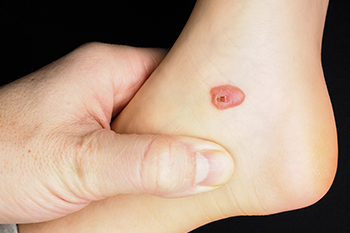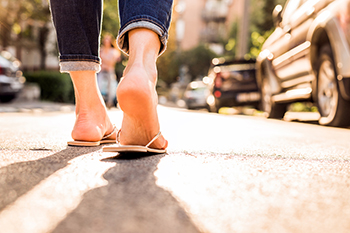Items filtered by date: June 2024
Causes and Duration of Foot Blood Blisters

Blood blisters on the foot are caused by friction or trauma that ruptures blood vessels under the skin without breaking the surface. This can occur from wearing ill-fitting shoes, engaging in vigorous activities, or sudden impact injuries. The resulting blister is filled with blood due to the broken capillaries beneath the skin. Blood blisters are generally more painful than regular blisters because of the pressure from the trapped blood. They typically last for about one to two weeks, during which time the body gradually reabsorbs the blood. To aid healing, it is important to protect the blister from further friction or pressure by using padded bandages and avoiding activities that aggravate the area. If you notice you have a blood blister on your foot, it is suggested that you schedule an appointment with a podiatrist who can help you to manage this condition.
Blisters are prone to making everyday activities extremely uncomfortable. If your feet are hurting, contact Donald Manger, DPM of Associated Podiatric Physicians, PA. Our doctor can provide the care you need to keep you pain-free and on your feet.
Foot Blisters
Foot blisters develop as a result of constantly wearing tight or ill-fitting footwear. This happens due to the constant rubbing from the shoe, which can often lead to pain.
What Are Foot Blisters?
A foot blister is a small fluid-filled pocket that forms on the upper-most layer of the skin. Blisters are filled with clear fluid and can lead to blood drainage or pus if the area becomes infected.
How Do Blisters Form?
Blisters on the feet are often the result of constant friction of skin and material, usually by shoe rubbing. Walking in sandals, boots, or shoes that don’t fit properly for long periods of time can result in a blister. Having consistent foot moisture and humidity can easily lead to blister formation.
Prevention & Treatment
It is important to properly care for the affected area in order to prevent infection and ease the pain. Do not lance the blister and use a Band-Aid to provide pain relief. Also, be sure to keep your feet dry and wear proper fitting shoes. If you see blood or pus in a blister, seek assistance from a podiatrist.
If you have any questions, please feel free to contact our office located in Hamilton Township, NJ . We offer the newest diagnostic and treatment technologies for all your foot care needs.
WhatI Is Sesamoiditis?

Sesamoiditis is a painful condition that affects the sesamoid bones, which are the small bones located beneath the big toe joint in the foot. These bones act as pulleys, aiding in movement and providing support for the tendons. Sesamoiditis occurs when these bones become inflamed or irritated, typically due to overuse or repetitive stress. Dancers, runners, and individuals who engage in activities that involve high impact on the feet are particularly susceptible to this condition. Common symptoms of sesamoiditis include pain and swelling surrounding the base of the big toe, which may worsen with activity and improve with rest. In some cases, there may be difficulty bending or straightening the big toe. If you have pain in this part of your foot, it is suggested that you visit a podiatrist who can accurately diagnose and treat sesamoiditis.
Sesamoiditis is an unpleasant foot condition characterized by pain in the balls of the feet. If you think you’re struggling with sesamoiditis, contact Donald Manger, DPM of Associated Podiatric Physicians, PA. Our doctor will treat your condition thoroughly and effectively.
Sesamoiditis
Sesamoiditis is a condition of the foot that affects the ball of the foot. It is more common in younger people than it is in older people. It can also occur with people who have begun a new exercise program, since their bodies are adjusting to the new physical regimen. Pain may also be caused by the inflammation of tendons surrounding the bones. It is important to seek treatment in its early stages because if you ignore the pain, this condition can lead to more serious problems such as severe irritation and bone fractures.
Causes of Sesamoiditis
- Sudden increase in activity
- Increase in physically strenuous movement without a proper warm up or build up
- Foot structure: those who have smaller, bonier feet or those with a high arch may be more susceptible
Treatment for sesamoiditis is non-invasive and simple. Doctors may recommend a strict rest period where the patient forgoes most physical activity. This will help give the patient time to heal their feet through limited activity. For serious cases, it is best to speak with your doctor to determine a treatment option that will help your specific needs.
If you have any questions please feel free to contact our office located in Hamilton Township, NJ . We offer the newest diagnostic and treatment technologies for all your foot and ankle needs.
Are You Suffering From Ingrown Toenails?
How Flip-Flops Affect the Feet

Flip-flops are a popular choice for summer footwear, but they can significantly impact foot biomechanics compared to walking barefoot. Studies comparing traditional flip-flops with more structured versions have highlighted differences in ankle movement and ground reaction forces. Traditional flip-flops often increase dorsiflexion, or the upward bending of the foot at the ankle as you walk. This happens because the toes grip to keep the shoe on. More structured flip-flops reduce ankle eversion, which is the outward rolling of the foot when you stand. This design offers better support and may lower the risk of overuse injuries by minimizing excessive ankle movement and reducing impact at the heel when your foot lands. Even so, the inherent design of flip-flops, which often requires gripping with the toes, can lead to discomfort and long-term foot issues. This gripping action can strain the muscles and tendons, leading to plantar fasciitis or tendonitis, among other problems. While flip-flops provide short-term convenience, they may not be ideal for prolonged use or activities that require a lot of walking. To ensure your footwear supports your foot health effectively or to address foot pain, it is suggested that you schedule an appointment with a podiatrist.
Flip-flops are not always the best choice of footwear. If you have any concerns about your feet or ankles, contact Donald Manger, DPM from Associated Podiatric Physicians, PA. Our doctor will assist you with all of your foot and ankle needs.
Flip-Flops and Feet
When the weather starts warming up, people enjoy wearing flip-flops. Flip-flops are comfortable, stylish, and easy to slip on and off; they're perfect for any summer beach goer. However, these shoes can cause harm to the feet.
How Can Flip-Flops Affect Me Long-Term?
- Ankle problems
- Hip problems
- Lower back problems
- Pain in the balls of the feet
- Problems with foot arches
- Changes in the way you walk
Are There Injuries Associated with Flip-Flops?
Yes. Since flip-flops are relatively weak and do not provide the same amount of support as sneakers, people who wear flip-flops regularly are more susceptible to injuries. On top of that, the open nature of the shoe makes your feet more prone to other problems, such as cuts and even infections. Common injuries and ailments include:
- Sprained ankles
- Blisters
- Infections
- Cuts and Scrapes
I like Wearing Flip-Flops. Are There Safe Alternatives?
When buying flip-flops, try to find ones that have sturdy soles and that are made of high-quality materials that will support for your feet. These flip-flops will cost more but will also last longer as a result.
If you have any questions please feel free to contact our office located in Hamilton Township, NJ . We offer the newest diagnostic and treatment technologies for all your foot and ankle needs.
Cracked Heels Can Be Unsightly and Painful
 Cracked heels occur when the skin on the heels becomes dry and thickens, leading to fissures. The cracks can be caused by prolonged standing, wearing open-back shoes, and skin conditions such as eczema or psoriasis. Cracked heels often appear as dry, rough patches with visible splits, which can feel painful and tender, especially when pressure is applied. Beyond their unsightly appearance, cracked heels can lead to serious complications. The deep fissures can become infected, causing swelling, redness, and bleeding. If left untreated, this can result in cellulitis, a painful bacterial skin infection. For individuals with diabetes or compromised immune systems, the risks are even greater because infections can spread easily and become severe. To prevent and treat cracked heels, it is suggested that you schedule an appointment with a podiatrist who can provide effective treatment solutions, and prevent further complications.
Cracked heels occur when the skin on the heels becomes dry and thickens, leading to fissures. The cracks can be caused by prolonged standing, wearing open-back shoes, and skin conditions such as eczema or psoriasis. Cracked heels often appear as dry, rough patches with visible splits, which can feel painful and tender, especially when pressure is applied. Beyond their unsightly appearance, cracked heels can lead to serious complications. The deep fissures can become infected, causing swelling, redness, and bleeding. If left untreated, this can result in cellulitis, a painful bacterial skin infection. For individuals with diabetes or compromised immune systems, the risks are even greater because infections can spread easily and become severe. To prevent and treat cracked heels, it is suggested that you schedule an appointment with a podiatrist who can provide effective treatment solutions, and prevent further complications.
If the skin on your feet starts to crack, you may want to see a podiatrist to find treatment. If you have any concerns, contact Donald Manger, DPM from Associated Podiatric Physicians, PA. Our doctor can provide the care you need to keep you pain-free and on your feet.
Cracked Heels
It is important to moisturize your cracked heels in order to prevent pain, bleeding, and infection. The reason cracked heels form is because the skin on the foot is too dry to support the immense pressure placed on them. When the foot expands, the dry skin on the foot begins to split.
Ways to Help Heal Them
- Invest in a good foot cream
- Try Using Petroleum Jelly
- Ease up on Soaps
- Drink Plenty of Water
Ways to Prevent Cracked Heels
- Moisturize After Showering
- Skip a Shower
- Keep Shower Water Lukewarm
- Don’t Scrub Your Feet
If you are unsure how to proceed in treating cracked heels, seek guidance from a podiatrist. Your doctor will help you with any questions or information you may need.
If you have any questions, please feel free to contact our office located in Hamilton Township, NJ . We offer the newest diagnostic and treatment technologies for all your foot care needs.

